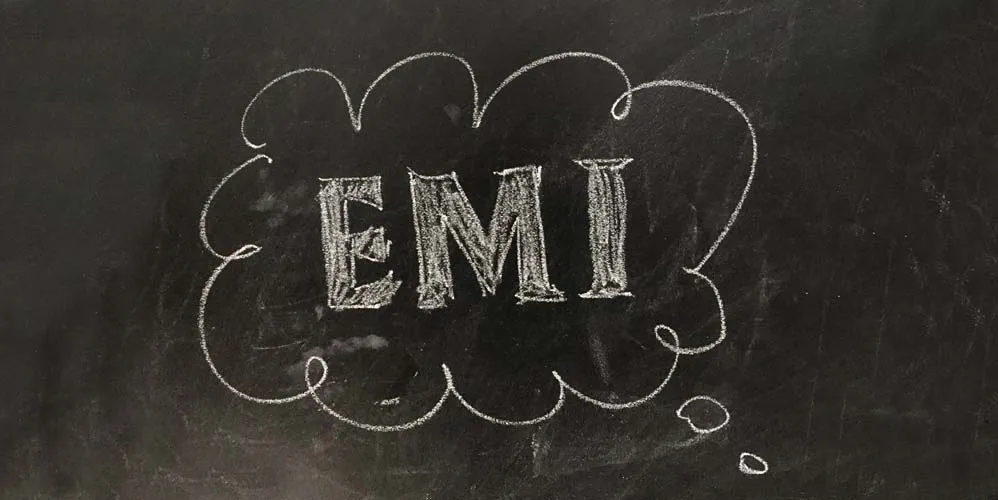
Understanding EMI: Full Form Meaning, Calculation, and Factors
29 Feb 2024

Table of Content
EMI Full Form
EMI is equated monthly instalments that the borrower pays to the lender over a fixed period on a set date each month.
EMI Meaning & Definition
From financing a smartphone to a car or apartment, EMIs are an individual’s best financial friend. EMIs help you to return your loan sum in a manageable capacity over a period. Though EMIs are extremely popular and friendly, there are still doubts amongst many who hesitate to take loans owing to their limited knowledge of EMIs.
So, what is EMI? It is a set of monthly payments provided by the borrower to the creditor on a particular day each month. EMI is a calculated sum of interest and principal that is paid over the years called loan tenure.
How does an EMI work?
Multiple factors determine the calculated sum of the EMI.
Principal borrowed :
The amount borrowed as a loan by the lender.
Rate of Interest:
Banks and financial institutes have different loan interest rates, the prevailing rate at the time of borrowing is fixed on your loan amount. Banks offer different types of interests. The fixed interest rates remain constant for the prefixed period regardless of the market condition. Floating rate of interest changes with market conditions. The rate of interest may increase or decrease depending on the market.
Tenure of the Loan :
The time taken to pay off.
Monthly/ Annual Resting Period :
Rests refer to the periodicity of charging interest to borrowers.
Also Read: Smart Ways to Calculate EMI on Personal Loan
How is EMI Calculated
EMIs, as discussed, have two components, the interest, and the principal amount. The interest is charged on the principal amount spread across the loan tenure.
How EMI is calculated for the flat rate method and reduced balance method? Let us understand what each stand for.
How is EMI Calculated for the Flat Rate Method?
In the case of progressive repayment, the interest rate on each repayment is charged by computing the original principal amount. This EMI calculation is determined when the whole loan principal is added with the total interest to the principal. The total number of EMI instalments is then divided by the time in the loan term. Flat-interest rate loan works on personal and auto loans. The loan interest payment covers the total principal amount, so if the borrower wants to make an early part payment, then the flat interest rate is more effective than the reducing balance loan strategy.
How is EMI Calculated for Reduce-Balance Method
Here the interest payment is determined by the outstanding principal amount. A progressive alteration will be noticed in the EMI interest and the principal payment component. The EMI is covered by a larger share of interest payment at the start of the term with the principal amount reduced. The interest amount gradually decreases over time with repayment while the principal begins to get larger in proportion. This reducing balance method is popular for home loan EMI , credit cards and overdraft services.
Banks calculate the interest rate on home loans through yearly, monthly, or daily reducing balances. For the annual reducing method, the interest on the principal is reduced at the end of the year. The lender continues to pay interest on a certain part of the principal, paid off to the lender. This reduces the monthly EMI over the annual reducing system.
Also Read: How does an EMI on debit card work?
For the monthly reducing system, with every EMI pay off, the principal, for which you pay interest, reduces monthly.
The daily reducing system sees a daily reduction of the principal for which you pay interest. The reduction starts from the day you start to pay EMI. The daily reducing system of EMI is less than the monthly reducing system, and the year is calculated as 365 days despite the days in February or a leap year.
Factors Affecting EMI
The loan affordability depends on the EMI backed with the principal and interest amount. It should be planned such that it does not affect your monthly budget. The interest rate, therefore, needs to be kept in mind along with many other factors that influence the interest rate which differs between lenders.
MCLR Rates :
The marginal Cost of Funds based Lending Rate (MCLR), is the minimum interest rate at which the bank can lend. Factors such as operating cost, Cash Reserve Ratio (CRR) and the marginal cost of funds along with any negatives carried on the CRR and tenure premium influence the rate. The bank reviews the MCLR annually for revising interest rates.
Different interest types
Fixed interest rates, floating interest rates and mixed interest rates all determine the EMI rate. The floating rate is based on the Reserve Bank of India (RBI) and varies according to what the RBI sets. Fixed interest rates remain unchanged throughout the certain period. Mixed loans start at fixed rates and switch to floating rates.
Loan-to-Value (LTV) Ratio
LTV ratio refers to the percentage of the property’s value you stand to get as the loan amount from your lender. The LTV Ratio is important, so the lender can evaluate how much they can sanction as a loan sum against your property value and ensure that your loan amount does not exceed your repayment capacity, or the price of the property.
Credit Score
A statement of your credit history reflects your financial discipline. If the credit score is less than 700, it shows that you are a high credit-risk borrower and will be charged a higher interest rate on a loan. On the other hand, those with low credit risk are also granted pre-loans.
Also Read: Why is a CIBIL Score Important?
Property positioning
If you are taking a home loan, the position of the property in terms of the locality, and connectivity will add to its resale value. If you purchase a property in a less valued area the resale value will be low. Properties with higher resale value have greater chances of loan approval as opposed to those with low resale value.
Borrowers Job
Your job stability and income also have a lot to do with the loan approval. Top-level salaried professionals, PSU and government employees are low risks among the salaried class; doctors and CAs are considered low risks among the self-employed class.
Loan tenure
Period in which you have to repay the loan plus interest amount.
EMI - Dos & Don't
When taking a loan there are things that you need to consider making your loan-taking and repaying journey smooth. We have listed a few Dos and Don’ts to help you get through the loan application and EMI journey without hurdles.
DOs
- Take a loan only if you can repay it
- Have a re-payment plan
- Before selecting the lender do a thorough market survey
- Check all terms and conditions
DONTs
- Don't default, and do not miss any repayment
- Don't risk taking multiple loans at the same time
- Unrecognised lenders should not be trusted, borrow from legitimate lenders
- The low-interest rate should not be the only factor in selecting a lender. Security, tenure, and your ability to repay matters
Also Read: How to Calculate EMI for Bike Loan: Tips and Tricks
FAQs
is the full form of EMI?
EMI full form in banking terms is Equated to Monthly Instalments.
Is EMI good or bad?
EMI is a convenient tool that enables loan repayment. Therefore, it can be said that it is a good practice for the serious loaner.
is the difference between EMI and a loan?
The loan is the amount that the bank or a financial institute lends to an individual. EMI is the equated monthly installment paid towards the loan at the agreed interest rate over a fixed tenure.
How is EMI deducted from a credit card?
If you are purchasing a product worth Rs.10,000, it could be anything from electronics to furniture, it can be converted to EMIs. The calculation of this EMI is based on the rate of interest charged by the bank, tenure, and the down payment provided by the borrower.
happens if I fail to pay the EMI on time?
If you fail an EMI payment, you will hurt your credit score. If you miss once, you will not be counted as a defaulter. Banks issue three consecutive reminders. If you respond with a late penalty fee, you can get back to the regular course. If not, banks send you a notice. You will be considered a minor defaulter if you pay the EMI within 90 days. If you fail to pay even beyond 90 days, it is a major default, and the loan account is classified as a non-performing asset (NPAs) by the bank.
Popular Articles
Tag Clouds
Related Articles


Understanding FCNR-B Account: A Secure and Advantageous Option for NRIs and PIOs








-
Disclaimer
The contents of this article/infographic/picture/video are meant solely for information purposes and do not necessarily reflect the views of Bank of Baroda. The contents are generic in nature and for informational purposes only. It is not a substitute for specific advice in your own circumstances. Bank of Baroda and/ or its Affiliates and its subsidiaries make no representation as to the accuracy; completeness or reliability of any information contained herein or otherwise provided and hereby disclaim any liability with regard to the same. The information is subject to updation, completion, revision, verification and amendment and the same may change materially. The information is not intended for distribution or use by any person in any jurisdiction where such distribution or use would be contrary to law or regulation or would subject Bank of Baroda or its affiliates to any licensing or registration requirements. Bank of Baroda shall not be responsible for any direct/indirect loss or liability incurred by the reader for taking any financial decisions based on the contents and information mentioned. Please consult your financial advisor before making any financial decision.
What is MICR Code? Understanding its Role in Banking Transactions
If you have used or even seen a cheque book, you must have noticed a few code numbers located at the bottom of every cheque leaf. This is a unique code for only bankers to decode and it plays an important role in banking transactions. This code is known as the Magnetic Ink Character Recognition (MICR) Code. Through this blog, you will get a thorough understanding of what an MICR Code is and its purpose in banking.
Understanding FCNR-B Account: A Secure and Advantageous Option for NRIs and PIOs
In today’s highly interconnected world, individuals often find themselves navigating international waters, either for work, education, or business. Non-resident Indians (NRIs) and People of Indian Origin (PIOs) are no strangers to this global movement, and as they traverse international landscapes, they often look out for solutions to manage their foreign earnings efficiently. One such financial instrument that caters to their needs is the Foreign Currency Non-Residential –Bank (FCNR-B) account, which will be thoroughly explored in this blog.


Leave a Comment
Thanks for submitting your details.